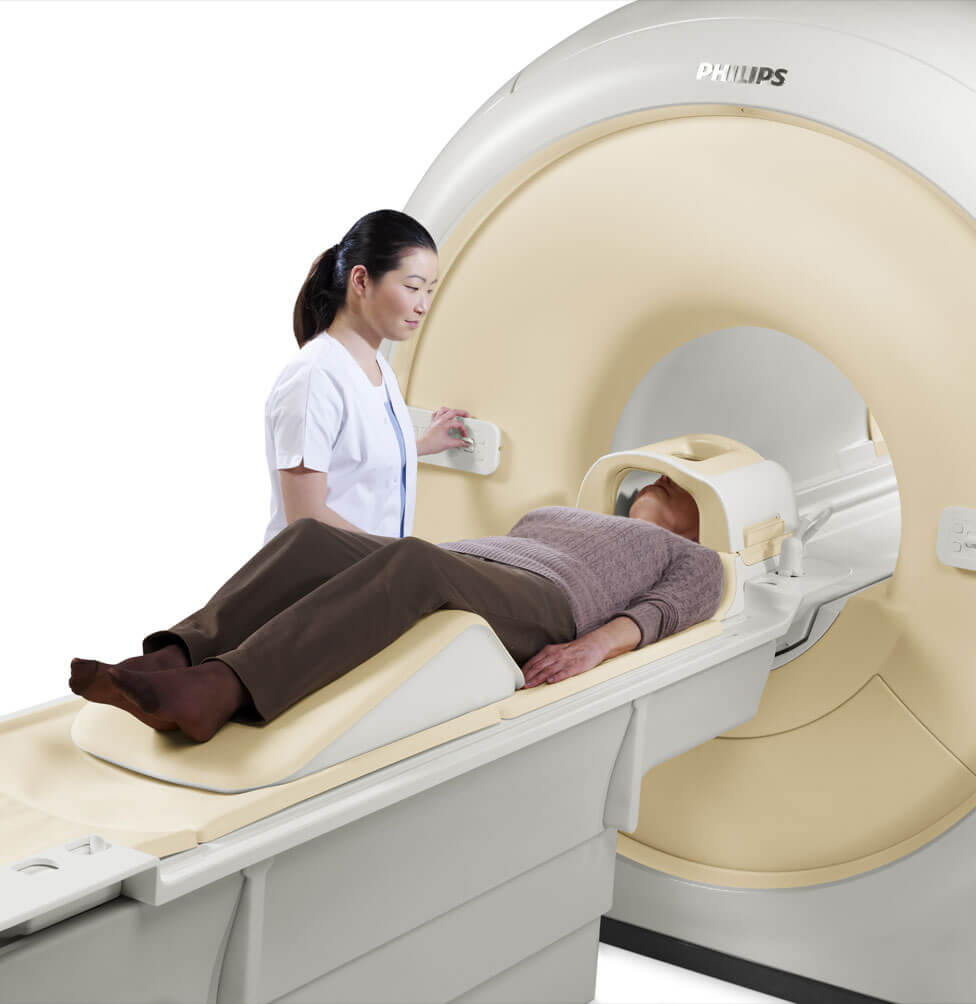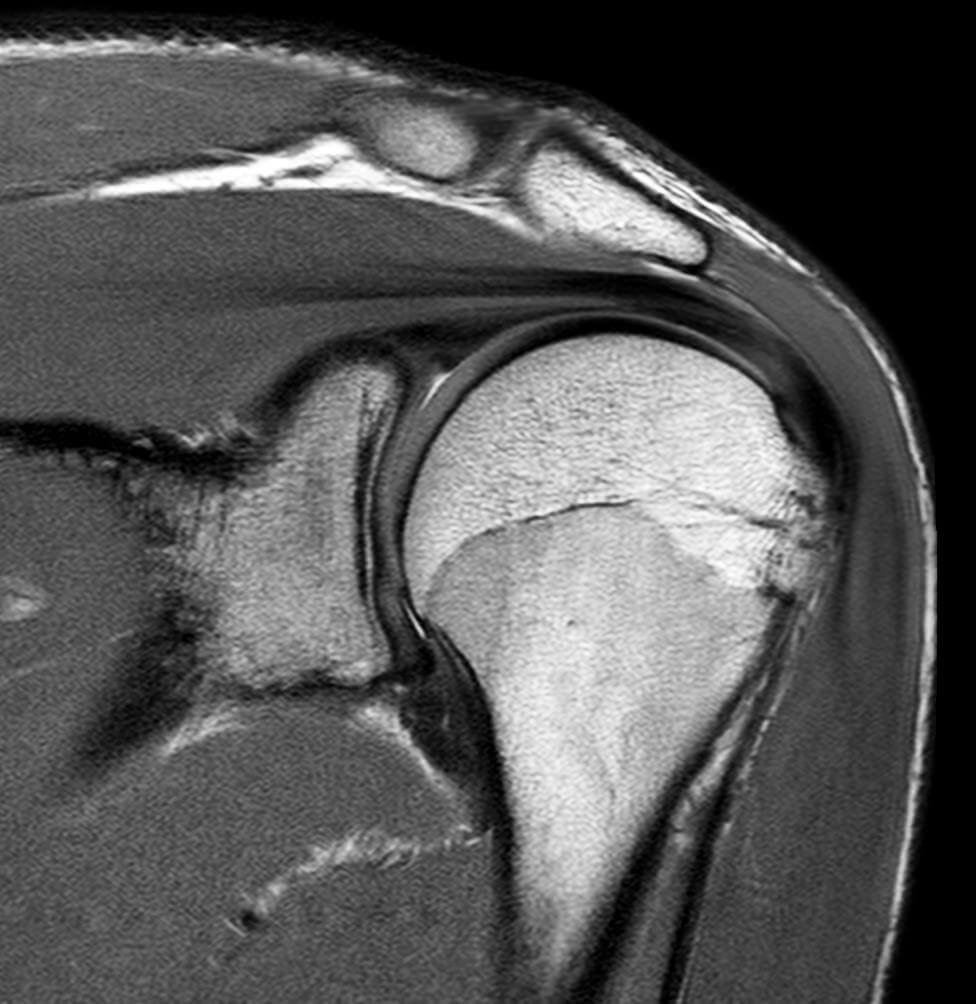Magnetic Resonance Imaging (MRI)
Patient Services:
What is a MRI?


Magnetic Resonance Imaging (MRI) is a scanning procedure that uses strong magnets and radiofrequency pulses to generate signals from the body. These signals are detected by a radio antenna and processed by a computer to create images (or pictures) of the inside of your body. As such, MRI does not rely on any ionising radiation like X-rays, or CT scans.
The MRI scanner is generally shaped like a large, circular box with a tunnel passing through it. A table, on which you lie, slides into the tunnel, or Bore as it is called. Depending on the type of examination, you may either be positioned head first or feet first. Both ends of the scanner are open and will not close. The tunnel has lights in it and often a mirror.
The MRIs at South East Radiology have the largest opening s in the industry, at 70cm. This enables our scanners to accommodate larger patients, and our tables have a weight limit of over 200kg.
What are the benefits of a MRI?
MRI has no known long-term harmful effects, provided the safety precautions are followed. MRI does not use radiation. Avoiding the need for exposure to radiation (X-rays) is of significant benefit to younger people and children, and MRI can also be used safely in pregnancy, if required.
MRI is capable of providing your doctor with a wide range of information about your body and particular diseases or conditions you might have. It can show certain conditions that other tests can’t show. The benefits of MRI depend on the part of the body being imaged.
MRI can image most parts of the body in any direction to obtain maximum information and provides this information in high-quality images. These images give accurate details about certain processes or structures within the body and can also provide information as data or graphs.
Why would my doctor refer me for an MRI?
There are many imaging procedures that help doctors look for and assess medical conditions. Different procedures provide different specialised information. Sometimes more than one type of imaging might be used to show information about a problem.
MRI might be the best way of showing certain problems, such as for a knee injury, the brain or spine. MRI is also often used to provide additional information to other tests, such as X-ray or ultrasound, and is particularly good at reviewing soft tissues in fine detail.
There are many different techniques or types of MRI scans that can be carried out. Each one offers the radiologist specific information, to best show what the problem might be. The information gained using MRI should help to diagnose the medical condition you might have.
How do I prepare for a MRI?
Safety in the MRI scanner is vital. The strong magnetic fields can attract and interfere with metal objects that you might have in or on you (including electronic and magnetic devices). Some of these interactions can cause harm or death.
To ensure it is safe for you to have an MRI, you will be required to complete a safety questionnaire either at time of booking your appointment, or prior to commencing the scan once you have arrived for your appointment.
If a friend or relative will be in the scanning room with you, they will also need to complete a safety questionnaire.
If you have a pacemaker or other implants, it is important to tell our staff before having the scan. An alternative test will need to be arranged, as these are not allowable within an MRI scanner.
- Objects in your body that can cause particular harm or be damaged include: pacemakers,
- aneurysm clips,
- heart valve replacements,
- neurostimulators,
- cochlear implants,
- metal fragments in the eye,
- metal foreign bodies,
- magnetic dental implants and drug infusion pumps.
Some of these implants, particularly more recent devices, might be safe to go into the MRI scanner, but all devices have to be accurately identified for the scan to proceed.
You should bring any documents about your implants to the appointment, and our staff might ask you or your doctor directly for more information on any implants you have. This information can help to correctly identify the type of implant to assess if it is safe for you to have the MRI.
It is important that you do not wear any makeup or hairspray, as many of these products have tiny metal particles that could interfere with the scan and reduce the quality of the images. They might cause the area to heat up and, on the rare occasion, burn your skin.
You will not be able to take anything with you into the scan room, and there are usually baskets or lockers available. It is easier if you leave objects such as watches, jewellery, mobile phones, belts, safety pins, hairpins and credit cards at home.
If you are pregnant, please discuss this with your doctor and tell our staff before having the scan.
If you are claustrophobic (a fear of small or enclosed spaces) and think you might not be able to proceed with the scan, advise your radiographer or receptionist at the MRI facility when making your appointment.
Sedative (calming) medication can be arranged with your doctor prior to the examination. If this happens, you will not be able to leave the facility until you are fully awake and someone else will need to drive you home.
Our MRI facilities have stereo players attached to the MRI scanner. You can listen to music whilst you are having the scan.
Fasting (going without food) for a MRI procedure might be required in some cases. When you make your MRI appointment, you will be advised of any fasting requirements. Continue to take all your normal medications, unless you are otherwise advised when you make the booking for your MRI scan.
Please bring any previous X-ray, computed tomography or ultrasound films. The radiologist might like to review the older studies or see if your condition has changed since your last scan.
Who does the MRI?
A radiographer or medical imaging technologist is a trained health professional who carries out MRI scanning. These radiographers have received additional and specialised training to operate these systems, and may hold additional accreditation and certification.
The radiologist is a specialist medical doctor who reviews and interprets the images and provides a written report of the test to your referring doctor, specialist or allied health worker.
What happens during a MRI and how long will it take?
The MRI procedure will be thoroughly explained to you, and your safety questionnaire reviewed and discussed before you are allowed to enter the scan room. You must not enter the MRI room until you have been instructed to do so by the radiographer.
You will usually be asked to change into a gown. This increases safety, with items in your pockets not being accidentally taken into the scan room.
You will be asked to lie on the scan table and given a buzzer to hold. When you squeeze it, an alarm sounds in the control room and you will be able to talk to the radiographer.
If you have any questions, please ask the radiographer who will be operating the MRI scanner, as it is important that you are comfortable and know what will be happening.
Once the scan starts, the radiographer will be able to see you from the control room throughout the scan.
The MRI scanner is very noisy during the scans. You will be given earplugs or headphones with music to reduce the noise to comfortable and safe levels.
Depending on the type of MRI you are having and your particular situation, you might have:
- leads placed on your chest to monitor your heartbeat if having a heart scan;
- a small plastic tube (pulse-oximeter) taped on your finger to check your breathing and heart rate if having sedative (calming) medication; and/or
- a needle inserted into a vein in your arm if any medication is required during the scan.
The most common medication injected is a contrast agent or ‘dye’ called gadolinium contrast medium. This highlights certain parts of the body being scanned, which will give more information to the radiologist who is assessing your scan.
The part of your body being scanned will be carefully positioned and gently secured, so you are comfortable and more likely and able to remain still. This region will then have a special antenna (known as a coil) positioned around it to pick up signals coming from your body, for the computer to create the required images.
The coils are usually encased in a plastic pad or frame. Depending on the part of the body being scanned, they might be wrapped around your shoulder, your knee or wrist, for your head and neck, and also may lie on top of your stomach or pelvis. Some coils are in the mattress of the scan bed, used when your back is being scanned.
The scan table will then move into the centre of the machine. Your head might be inside or outside the scanner, depending on the part of the body being scanned.
When the scan begins, you will hear a knocking noise that continues during each scan. Scanning is not continuous, and each scan varies in length from about 1 to several minutes, with a break in between. You will be able to talk to the radiographer between each scan and can press the buzzer if you are not comfortable or want to come out of the machine at any time.
The scanning process is painless. You might feel slightly warm during scanning. If you do feel anything at all, it is important you tell the radiographer carrying out the scan.
It is critical that you lie extremely still and hold your position during the scan.
In general, you can breathe normally. Occasionally, during some types of MRI, you will need to hold your breath. Breathing and movement can make the images blurry and assessment of your problem more difficult, and result in more scans being repeated.
Several small scans, or “sequences” will be done, and will comprise the entire study. Each of the sequences can take between 3-4 minutes to be completed.
So overall, the scan can take between 20 minutes, or up to an hour to complete. This depends on the part or parts of the body being imaged, what type of MRI sequences are required, if you have held very still, or if contrast is needed.
Are there any after effects of a MRI?
There are no after effects of the MRI itself. You will be able to carry on your day as planned once the test has been completed.
If you required any sort of sedation for the scan, you will not be able to leave until you are fully awake and you will need someone to drive you home.
What are the risks of a MRI?
There are no known side-effects of an MRI, providing you do not have any implants or objects that must not go in the scanner.
The danger from the MRI is due to interactions of objects with magnetic fields. Metal objects can move, as well as get hot, and electrical currents can be produced and lead to malfunction of a device. A strong magnet can alter or wipe information from other magnetic devices. Some of these interactions can cause harm or death.
As discussed, some implants, such as pacemakers, defibrillators, hearing devices and drug pumps, make it unsafe for a person to have a scan. It is important you complete the safety questionnaire fully and contact our staff where you are having the MRI if you have any questions about the implants you have.
Metal objects that are attracted to magnets (called ferromagnetic objects), such as buckets, chairs or objects in your pocket, can be pulled rapidly, like a missile, into the MRI machine.
These can damage the machine, as well as injure anyone in the way. People have died due to injuries cause by this.
Other metal in your body might move if not well fixed. These would include metal fragments in your eyes, which can interfere with vision if they move in the MRI. Most implants (hip replacements for example) are well fixed, and are usually made of non-magnetic or only weakly magnetic materials and are not a problem.
Clips in the brain, used on an aneurysm (dilated blood vessel or out-pouching of a vessel), must be non-magnetic or they cannot be scanned.
Heating of metal can cause burns, such as from necklaces, and these will be removed before the scan. Some catheters (fine tubes usually in your blood vessels) can melt if they contain a wire.
Electronic devices can be damaged and not work – by moving in the body, heating and also having abnormal electrical currents. A pacemaker is a common device that can exclude you from having an MRI scan.
Magnetic dental implants will no longer remain attached if placed in the strong magnetic fields of the MRI scanner. Magnetic strips, such as on credit cards, can also be damaged.
If you are pregnant, please discuss the scan with your doctor and tell the MRI facility before your procedure. This will not necessarily stop you from having the scan. There are no reported effects of an MRI on the unborn child, but caution is always used in pregnancy.
If you are required to have an injection of gadolinium contrast medium, there is a very small risk of an allergic reaction. Gadolinium contrast medium is generally very safe, but as with all medications, allergic reactions can occur. Minor reactions (such as hives or itchy eyes) can occur in approximately 1 in 1000 people. More significant reactions (difficulty in breathing or collapse) might occur in 1 in 10,000 people. Our staff in our practice where you are having the scan will treat you if you have an allergic reaction. There is a small risk of an allergic reaction to any of the medications that might be given during an MRI scan.
If you have a history of kidney disease, you should have a blood test before the scan to ensure that the contrast medium can be given safely. Nephrogenic systemic fibrosis is a rare, but serious complication following a gadolinium chelate injection (see Gadolinium Contrast Medium (MRI Contrast agents)) in people with very poor kidney function.
The chance of an allergic reaction to the contrast medium is very small, but please ask the MRI radiographer about the injection to obtain more information.
When can I expect the results of my MRI?
The time that it takes your doctor to receive a written report on the test or procedure you have had will vary, depending on:
- the urgency with which the result is needed;
- the complexity of the examination;
- whether more information is needed from your doctor before the examination can be interpreted by the specialist;
- whether you have had previous X-rays that need to be compared with this new test or procedure
- SER will have x-ray results to your referring doctor within 24 hours of examination.

